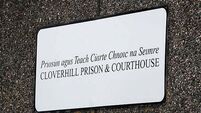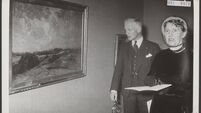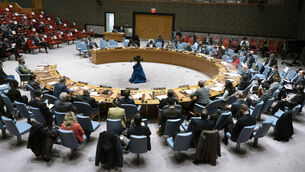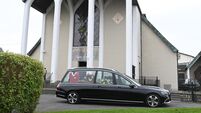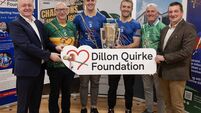Charity work can shield scoundrels like Savile and Armstrong from scrutiny
They seemed to be nerving up one of their number to tackle something extraordinarily difficult. That something turned out to be articulating the name of a disease.
“Prostate cancer. There. I’ve said it,” Matt Cooper’s voice said bravely. (He sounded like an escapee from the Famous Five. They’re the only people I’ve ever encountered who say things like “There, I’ve said it.”) He then egged another one of the guys to do the same. At the end of the ad, they all seemed ridiculously pleased with themselves and noble with it. The point seemed to be that if they could get the courage to name the disease out loud in company, they might also have the guts to go to a doctor and have themselves checked out for evidence of the disease. As the Irish Cancer Society, which was behind the ad, would want. Lots of lads who might otherwise never thought of their prostate until it turned nasty on them, no doubt went and took preventive action. That was the experience following the death of reality TV star Jade Goody. The numbers pitching up for cervical smear tests rocketed, because of the publicity her dying gave to the dangers of cervical cancer. An increase in early detection in excess of 19% was recorded the following year. Literally thousands of lives were saved, as a result, and a young woman who in life was a loud-mouthed vulgarian ended up, in death, doing immeasurable good. Because she was — briefly — famous.
Attaching a famous name to a good cause or worthy issue is a classic way of drawing attention to that cause or issue. Justin Forsyth, CEO of Save the Children, has said: “Without the campaigning energies of Bono, Bob Geldof, and Richard Curtis, for example, I don’t believe 46m more children would be in school today in some of the world’s poorest countries.”
Ireland is blessed to have a number of celebs, including Miriam O’Callaghan and George Hook, who willingly lend their presence, their face, and their voice to events that might otherwise struggle to get publicity. They turn up for free, say a few words, pose for pictures, accept bouquets (well, Miriam does), and for one brief shining moment draw the eye of the camera to the charity involved.
Others tie themselves to a single charity. So Marian Finucane appears on behalf of the Hospice and Cathy Kelly acts as ambassador for Unicef. All these methodologies are a country mile away from real or virtual ownership of a charity, as is the case with Lance Armstrong and as was the case with Jimmy Savile. Those who make the decision to turn a celeb into the personification of an issue would maintain that the payoff is simply enormous, and up to now, that view wouldn’t have dragged a chain of caveats behind it. Savile as the front man for the Central Remedial Clinic made their annual fundraiser into a monumental success, providing benefits to many people with physical disabilities.
That the payoff is two-way is infrequently acknowledged. Take, for example, Princess Diana’s fronting for the anti-landmine campaign. The photograph is unforgettable. Slender figure in cotton trousers, walking gingerly, her head surrounded by an anti- blast helmet. How brave, said the world, just as it had said when she touched people suffering from Aids. Of course, in neither case was courage involved at all. The princess was in no danger. No possibility that the landmine people would walk her through an area seeded with live mines, and not even in the days when HIV was surrounded with hysteria did anybody believe that gently touching the forearm of an infected person would infect the toucher. The reality was that the princess of Wales was a troubled, manipulative woman with not much between her ears other than a concern with how famous she was on any given day. Becoming the personification of a couple of causes lent her gravity and perceived courage at the price of a photo opportunity. Cheap.
WHAT the recent revelations about Armstrong and Savile reveal, however, is something much more serious, of much longer-term concern. Marketing specialists have always known that to become the face of a charity is to be clothed in the virtues and values of that charity (or NGO). The question that now needs to be asked is this: Can fronting for a carefully chosen charity empower the celebrity to take actions they might otherwise not be able to take, enrich the celebrity in some way or create for the celebrity a protected but spurious reputation which, in the public mind, outweighs or distracts from a venal reality? Armstrong’s survival of cancer made him more likeable. It’s one of life’s great oddities, the way going through a life-threatening disease or a major car crash turns the individual into a hero. Suffering bravely endured is, of course, admirable, but does not, in and of itself, fill the sufferer with new insight or external credibility, although that’s widely assumed to be the case. Like believing that visually impaired people get a sixth sense for free by way of compensation for being blind, we like to think that someone who’s gone close to the portals of death must see life in a different and better way, thereafter.
This might be more rigorously examined. Lance Armstrong, according to team mates and many in media, was obnoxious long before he got cancer, and was just as obnoxious after he recovered from cancer. Sustained improvement in his public image was largely driven by his charity, Livestrong, which seems to have given him endless opportunities for positive PR, just as involvement with Stoke Mandeville Hospital and other charities did for Savile.
In Savile’s case, the charity work not only branded him, but armoured him and — it may now be argued — empowered him. According to allegations, it empowered him to select under-age girls, some of them with physical disabilities, some with other challenges making them particularly open to attention being paid by someone “famous off the telly”. It’s when those making the allegations are asked why they didn’t speak up sooner, or why, if they did speak up sooner, nothing happened, that the armour effect becomes apparent. Getting picky about the prurient habits of a man who raised such funding for such good causes? Come on.
In Armstrong’s case, the charity ensured the public and media honeymoon delivered by his cancer would continue ad infinitum. Empowering him to run websites which lay heavy emphasis on buying branded goods and armouring him against the inevitable, long after rumour had turned rancid.
Maybe it’s now time to widen Samuel Johnson’s opinion that “patriotism is the last refuge of the scoundrel”. In exceptional circumstances, public leadership of a charity can also be the last refuge of the scoundrel.





